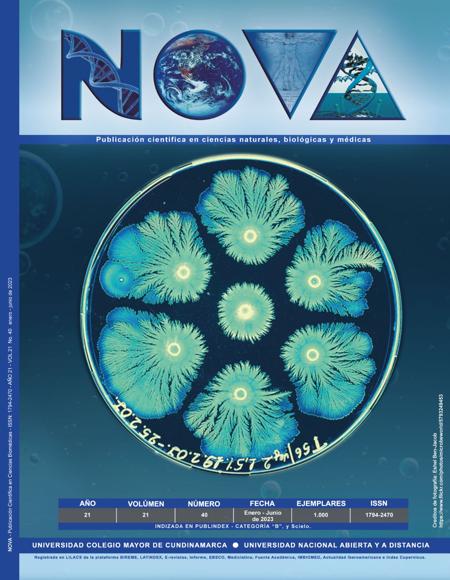Percepción de los estudiantes de programas de salud sobre el uso de una herramienta de realidad aumentada en prácticas anatómicas
Percepción de los estudiantes de programas de salud sobre el uso de una herramienta de realidad aumentada en prácticas anatómicas

NOVA por http://www.unicolmayor.edu.co/publicaciones/index.php/nova se distribuye bajo una Licencia Creative Commons Atribución-NoComercial-SinDerivar 4.0 Internacional.
Así mismo, los autores mantienen sus derechos de propiedad intelectual sobre los artículos.
Mostrar biografía de los autores
Introducción: La realidad aumentada en el campo de la medicina tiene un crecimiento continuo, brindando apoyo en componentes teóricos y prácticos. Esta tecnología presenta un entorno seguro para la experimentación de estudiantes de ciencias de la salud. Objetivo: La presente investigación analiza la influencia sobre la aceptación de estudiantes de laboratorios de morfología con la herramienta de realidad aumentada HOLOMARKERS. Esta herramienta permite al usuario colocar alfileres virtuales sobre material biológico humano para un etiquetado de tejidos, músculos y órganos, evitando contacto directo con la muestra. Metodología: Para analizar la influencia de HOLOMARKERS en la aceptación de los estudiantes, se usó un modelo de aceptación de la tecnología. Cada uno de los cuatro núcleos del modelo se constituye por cuatro preguntas en escala Likert. El tamaño de la población encuestada es 17 estudiantes de ciencias de la salud. Resultados: La aceptación de HOLOMARKERS por parte de los estudiantes es influenciada por la utilidad percibida de la herramienta y la formación teórica previa de los estudiantes. Conclusiones: Los estudiantes encuestados resaltan la utilidad de HOLOMARKERS para el desarrollo de las prácticas en el laboratorio de anatomía macroscópica con material biológico humano.
Visitas del artículo 107 | Visitas PDF 102
Descargas
- Mann S, Novintan S, Hazemi-Jebelli Y, Faehndrich D, others. Medical Students' corner: lessons from COVID-19 in equity, adaptability, and Community for the Future of medical education. JMIR Medical Education. 2020;6(2):e23604.
- https://doi.org/10.2196/23604
- Parekh P, Patel S, Patel N, Shah M. Systematic review and meta-analysis of augmented reality in medicine, retail, and games. Visual Computing for Industry, Biomedicine, and Art. 2020;3-20.
- https://doi.org/10.1186/s42492-020-00057-7
- Álvarez de Weldefort, A., & Campuzano, S. (1). Control de la contaminación biológica en los laboratorios de docencia de la Universidad Colegio Mayor de Cundinamarca en Bogotá, Colombia. NOVA, 1(1). https://doi.org/10.22490/24629448.1052.
- Milgram P, Kishino F. A taxonomy of mixed reality visual displays. IEICE TRANSACTIONS on Information and Systems. 1994;77(12):1321-9.
- Biljecki F, Stoter J, Ledoux H, Zlatanova S, Çöltekin A. Applications of 3D city models: State of the art review. ISPRS International Journal of Geo-Information. 2015;4(4):2842-89.
- https://doi.org/10.3390/ijgi4042842
- Díaz Zamora W, León Guatame AX, Robayo-Pinzon O. Comercialización social de la donación de órganos en Colombia: un estudio exploratorio. Health Marketing Quarterly. 2020;37(3):232-44.
- https://doi.org/10.1080/07359683.2020.1802982
- Vargas Hernández, J., & Gacharná de Beltrán, H. (2008). Capacidad de búsqueda bibliográfica: investigación formativa con estudiantes de Bacteriología y Laboratorio Clínico de la Universidad Colegio Mayor de Cundinamarca. NOVA, 6(9). https://doi.org/10.22490/24629448.399.
- https://doi.org/10.22490/24629448.399
- Gerup J, Soerensen CB, Dieckmann P. Augmented reality and mixed reality for healthcare education beyond surgery: an integrative review. Int J Med Educ. 2020;11:1.
- https://doi.org/10.5116/ijme.5e01.eb1a
- Millan, J., & Yunda, L. (2014). An Open-Access Web-based Medical Image Atlas for Collaborative Medical Image Sharing, Processing, Web Semantic Searching and Analysis with Uses in Medical Training, Research and Second Opinion of Cases. NOVA, 12(22). https://doi.org/10.22490/24629448.1036
- https://doi.org/10.22490/24629448.1036
- Ha HG, Hong J. Augmented Reality in Medicine. Hanyang Medical Reviews. 2016;36(4):242.
- https://doi.org/10.7599/hmr.2016.36.4.242
- Hanna MG, Ahmed I, Nine J, Prajapati S, Pantanowitz L. Augmented reality technology using Microsoft HoloLens in anatomic pathology. Arch Pathol Lab Med. 2018;142(5):638-44.
- https://doi.org/10.5858/arpa.2017-0189-OA
- Maniam P, Schnell P, Dan L, Portelli R, Erolin C, Mountain R, et al. Exploration of temporal bone anatomy using mixed reality (HoloLens): development of a mixed reality anatomy teaching resource prototype. Journal of Visual Communication in Medicine. 2020;43(1):17-26.
- https://doi.org/10.1080/17453054.2019.1671813
- Stojanovska M, Tingle G, Tan L, Ulrey L, Simonson-Shick S, Mlakar J, et al. Mixed reality anatomy using Microsoft HoloLens and cadaveric dissection: a comparative effectiveness study. Med Sci Educ. 2020;30(1):173-8.
- https://doi.org/10.1007/s40670-019-00834-x
- Barroso Osuna J, Cabero Almenara J, Moreno Fernández AM. La utilización de objetos de aprendizaje en Realidad Aumentada en la enseñanza de la medicina. Innoeduca International Journal of Technology and Educational Innovation. 2016 Nov 27;2(2):77.
- https://doi.org/10.20548/innoeduca.2016.v2i2.1955
- Pelanis E, Kumar RP, Aghayan DL, Palomar R, Fretland ÅA, Brun H, et al. Use of mixed reality for improved spatial understanding of liver anatomy. Minimally Invasive Therapy & Allied Technologies. 2020;29(3):154-60.
- https://doi.org/10.1080/13645706.2019.1616558
- Karambakhsh A, Kamel A, Sheng B, Li P, Yang P, Feng DD. Deep gesture interaction for augmented anatomy learning. International Journal of Information Management. 2019;45:328-36.
- https://doi.org/10.1016/j.ijinfomgt.2018.03.004
- Gibby JT, Swenson SA, Cvetko S, Rao R, Javan R. Head-mounted display augmented reality to guide pedicle screw placement utilizing computed tomography. Int J Comput Assist Radiol Surg. 2019;14(3):525-35.
- https://doi.org/10.1007/s11548-018-1814-7
- Sirilak S, Muneesawang P. A new procedure for advancing telemedicine using the HoloLens. Ieee Access. 2018;6:60224-33.
- https://doi.org/10.1109/ACCESS.2018.2875558
- Saito Y, Sugimoto M, Imura S, Morine Y, Ikemoto T, Iwahashi S, et al. Intraoperative 3D hologram support with mixed reality techniques in liver surgery. Annals of Surgery. 2020;271(1):e4-e7.
- https://doi.org/10.1097/SLA.0000000000003552
- Richardson T, Gilbert S, Holub J, MacAllister A, Thompson F, Radkowski R, et al. Fusing self-reported and sensor data from mixed-reality training. 2014;
- Evans G, Miller J, Pena MI, MacAllister A, Winer E. Evaluating the Microsoft HoloLens through an augmented reality assembly application. In: Degraded environments: sensing, processing, and display 2017. 2017. p. 282-97.
- https://doi.org/10.1117/12.2262626
- Pérez-Muñoz A, Garzón-Martínez M, Pineda-Gómez AI, Miranda-Cruz ÁD, Villamizar-Gómez L. Acquired skills with laparoscopic simulators in gynaecological laparoscopic surgery training programs: A review of reviews. Vol. 20, Educacion Medica. Elsevier Espana S.L.U; 2019. p. 309-24.
- https://doi.org/10.1016/j.edumed.2018.10.013
- Eckert M, Volmerg JS, Friedrich CM, others. Augmented reality in medicine: systematic and bibliographic review. JMIR Mhealth Uhealth. 2019;7(4):e10967.
- https://doi.org/10.2196/10967
- Munzer BW, Khan MM, Shipman B, Mahajan P. Augmented reality in emergency medicine: a scoping review. J Med Internet Res. 2019;21(4):e12368.
- https://doi.org/10.2196/12368
- Cabero Almenara J, Barroso Osuna J, Obrador M. Augmented reality applied to the teaching of medicine. Educacion Medica. 2017 Jul 1;18(3):203-8.
- https://doi.org/10.1016/j.edumed.2016.06.015
- Robinson BL, Mitchell TR, Brenseke BM. Evaluating the use of mixed reality to teach gross and microscopic respiratory anatomy. Medical Science Educator. 2020;30(4):1745-8.
- https://doi.org/10.1007/s40670-020-01064-2
- Kumar N, Pandey S, Rahman E. A novel three-dimensional interactive virtual face to facilitate facial anatomy teaching using Microsoft HoloLens. Aesthetic Plastic Surgery. 2021;45(3):1005-11.
- https://doi.org/10.1007/s00266-020-02110-5
- Hopkins WG, Marshall SW, Batterham AM, Hanin J. Progressive statistics for studies in sports medicine and exercise science. Vol. 41, Medicine and Science in Sports and Exercise. 2009. p. 3-12.
- https://doi.org/10.1249/MSS.0b013e31818cb278
- Nagy JT. Evaluation of online video usage and learning satisfaction: An extension of the technology acceptance model. International Review of Research in Open and Distributed Learning. 2018;19(1).
- https://doi.org/10.19173/irrodl.v19i1.2886
- R Core Team. R: A Language and Environment for Statistical Computing [Internet]. Vienna, Austria; 2021. Available from: https://www.R-project.org/





